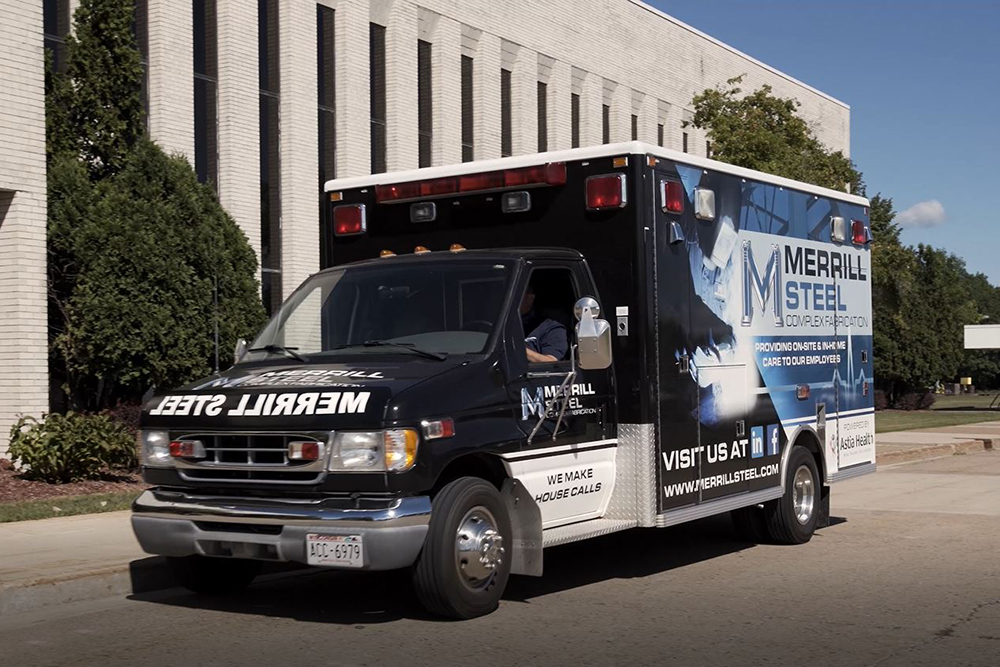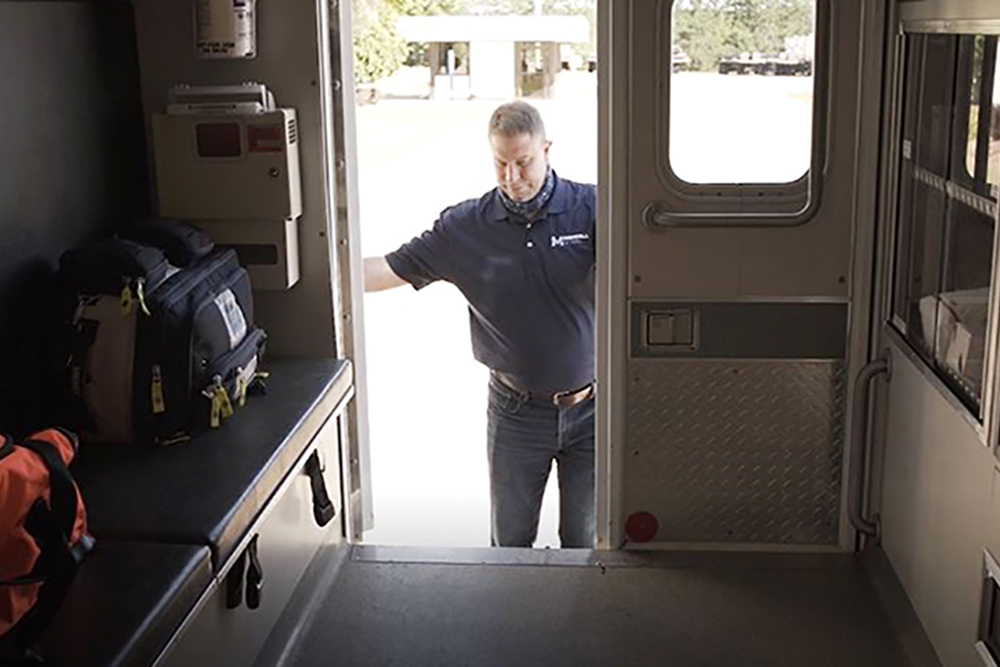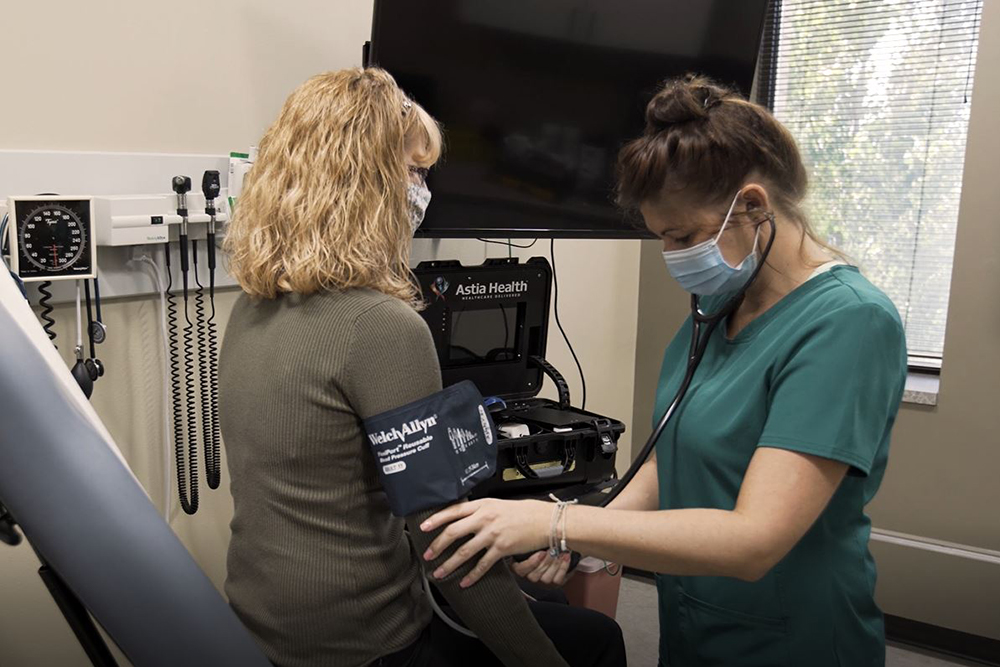The Alliance awarded Matt Ohrt, VP of HR and Medical Services at Merrill Steel, with a Health Transformation Award on Oct. 1, 2020, in recognition of significantly improving his community’s access to high-value health care by creating an on-site and mobile clinic. This case study explains how he did it.
Planting The Seeds Of Change
Matt first started down the path of creating a clinic after some internal discussions within Merrill Steel. He had experimented with smaller initiatives in the past that involved a nurse practitioner on-site, but never at this magnitude or level.
“I joined Merrill Steel in 2016, and building a clinic was something that the ownership and I had talked about for a while but just never made happen,” Matt said. “So the idea was there. We just needed someone to put it all together.”
It turns out Matt was just the person to do it. What finally made it click? Matt’s burning desire to jumpstart the clinic happened after seeing just how poorly Wisconsin compared to other states in terms of health costs.
We learned that Wisconsin is the second-highest state for health care costs, so this ground is prime for change, and any seeds we plant now can be big wins for the future.
“Also, it kind of becomes a necessary action when you see the disparity from, say Michigan, that’s averaging about 150% of Medicare, while Wisconsin is averaging 400% of Medicare.”
Matt was likely referring to RAND Corporation’s Hospital Price Transparency Study, which used claims data to compare hospital prices paid for by privately insured patients as a percentage of Medicare.
“When the prices aren’t shared up-front, you end up getting surprise bills after the fact, which can be very upsetting,” Matt continued.
“It’s driving families into bankruptcy, and having liens put on their homes, or getting their wages garnished.
“And there’s really no accountability to whether those prices were even fair to begin with.”
Once Matt understood how damaging the cost of health care was to his community, he began working to improve the quality and accessibility for his nearly 500 employees by implementing a direct primary care clinic on-site.
Digging Deep For Future Savings
“We had an 1800-sq. ft. area that we wanted to turn into our on-site clinic, but it needed to be completely remodeled,” said Matt. “It was in 1978-mode, and we wanted a true, modern, on-site clinic with all the resources and facilities.”
It would not be easy. They needed a state permit to recreate the space and received two commercial bids for the project – the cheaper of the two came in at $370,000.
“We thought, ‘Boy, we could build something for that,’ but we really wanted it to be on-site.” So Matt decided to take matters into his own hands – quite literally – and went to Merrill Steel’s ownership with an unusual proposal.
“After the second commercial bid, I looked at one of the owners and said, ‘I have a background in general contracting. I can find subcontractors and manage this process for us.’”
Matt did general contracting for seven years throughout his college career, and with ownership’s blessing, he used that experience to assemble his team and started building the clinic in-house.
The Fruits Of Labor
“At the end of the day, we built a really nice facility with a brand new ceiling – which wasn’t included in the original bids we received – for about $150,000.”
Then, Matt’s team filled the space with $100,000 worth of new, top-of-the-line equipment and furniture: chairs, desks, blood and lab machines, and portable X-ray and ultrasound machines.
When it was all said and done, Merrill Steel’s initial, up-front investment totaled a quarter of a million dollars – all before they saved a single cent.
A Big Return On Investment
Although the price of admission wasn’t cheap, Matt rewarded his ownership’s faith in him by providing happier, healthier employees and a quick return on investment.
We’re self-insured, and we’re spending over $5 million on health care, writing checks for stop-loss insurance, etcetera – so cost was a big factor for us. Once we started looking at the savings, we realized we saved 20% off our total health care cost.
Not only did they recoup their initial investment, but Merrill Steel produced a chart to track their expenses against the traditional way to pay for health.
“Before 2016, we were seeing 9% cost increases year after year. When we look at had we just accepted those cost increases, and compare that with what we’ve done instead, our savings have reached $4 million since then.”
Matt stressed that Merrill Steel sought those savings without sacrificing their employees’ quality of care – which is always top-of-mind for Merrill Steel.
“It’s important to note that the company saves money to keep premiums down and benefits high, so our employees and their families save equally. It’s a win-win kind of thing.”
The Doctor Is In… Your House
But Matt didn’t stop there. Once Merrill Steel started realizing those significant savings from the clinic, they were able to focus on other areas they could save, too – all while improving their employees’ access to high-value health care.
A large portion of Merrill Steel’s health care costs were being spent on expensive services like MRIs, ultrasounds, and X-rays, and considering how rough-and-tough the nature of steelwork can be, those stats are not unique – but how Matt solved it was.
He actually bought and refurbished an old ambulance, turning it into a mobile health clinic for his employees and their families – one that makes house calls to their homes.
Driving Towards High-Value Health Care
Giving new meaning to direct primary care, the mobile clinic provides special accessibility to health care services and saves Merrill Steel and its employees on health care costs by avoiding urgent care and emergency room services.
“The idea for the mobile clinic came from Astia Health’s owner, Alex Sommers, who had kind of done the same thing out in the community,” said Matt.
And yet again, he got full support from Merrill Steel’s president, who drove over five hours with him to look at ambulances. They found one in really great condition, so they bought it and wrapped it beautifully in their company’s branding.
Matt explained that the mobile clinic isn’t really meant for ER transport, but more specifically for home care needs: “Let’s say you’re a parent that doesn’t want to drag the kids out in the dead of winter. We can just send the mobile clinic over, and it’s free within a 30-mile range.”
And beyond the sheer convenience of the clinic, it’s a vehicle for prescription medications, injury treatment, and is even outfitted with a mobile X-ray machine.

The On-Site And Mobile Clinic Combination
Merrill Steel offers some incredible services for its employees and their families between the on-site clinic and the mobile clinic.
The on-site clinic provides a robust set of services above-and-beyond what even some health systems have in place – IVs, lab work, casting services, suturing, MRIs, X-rays, and physical therapy – and all at equivocal or lower costs than what their local health systems charge.
“We can also prescribe,” Matt added. “So, if someone needs an ongoing medication, they don’t have to wait three months for an appointment. They can walk into our clinic pretty much the same day and get treatment. And if they just need to renew a prescription, they don’t have to pay for a doctor’s visit, which, traditionally, can sometimes cost a patient several hundred dollars just to get that single prescription renewed.”
The clinic’s success became contagious for Merrill Steel, and in 2019 they constructed another on-site clinic at their Springfield, Missouri location, so that all employees and their families would have convenient access to affordable primary care. It’s still early, Matt said, but so far, it’s proved to be a good investment.
Starting: The First Step Towards Success
Matt reiterated that crafting a mobile health clinic was not part of the original vision and that the on-site clinic was the first and foremost goal towards improving the quality and delivery of care for his employees. Step-by-step, the successes that came after each goal were the result of the one before it.
He also admitted that they encountered multiple obstacles along the path towards $4 million in savings but explained that they solved those as they came up, one-by-one, too.
I think the biggest thing that set us up for success was simply starting.
“We’ve learned so much along the way by just being resourceful, but initially, we didn’t know how this would go. Looking at the owners and saying they’re going to drop a $200,000 or $300,000 investment without knowing the ROI was kind of risky and a little scary.”
That uncertainty is one of the biggest roadblocks people like Matt face in implementing an on-site clinic: getting their leadership on board. But luckily for Matt, Merrill Steel, and its employees, the owners gladly jumped on board.
“They made a huge up-front investment not knowing how it would turn out,” he said. “We actually got our return on investment really quickly, but you don’t know those kinds of things going in, so that trust and support has been really big on our journey of improving health care.”
Matt clarified that Merrill Steel’s leap of faith wasn’t just a shot in the dark, either; it was guided by due diligence and research on his part.
“We had done our research, and we had looked at all the different vendors, and it’s something that, thankfully, we went with, because it’s certainly been a neat success story for us and our employees and their families.”
Growing Pains
After the clinic was established, Matt and Merrill Steel continued to face barriers, but ultimately, they would overcome them. They quickly found out the key to a great clinic was great, tenured staff.
“I think like anything new, we had a few bumps in the road. We had some good nurse practitioners, but within the first year-and-a-half, we experienced some turnover. So you work through those challenges, and now, where we’re at today, we have among the best providers and NPs I’ve ever met; they’re second to none, and I would recommend them above anyone, anywhere.”

Building Trust For Employee “Buy-In”
However, having a top-of-the-line clinic filled with amazing staff doesn’t automatically translate into better health care and savings. Employers need to get their employees to utilize the resources they offer.
“We offer these services to all of our employees and their dependents, and in Wisconsin, we have around 600 members. That puts us in the 60-70% range in terms of participation, so gaining more participation – more like in the 90% range – is still an opportunity for us.”
Building trust and getting a hardworking, salt-of-the-earth type workforce takes time, educational resources, and constant communication. Merrill Steel made a deliberate decision to promote constant contact between their employees and their clinic provider, Astia Health.
“Every year we have Astia Health come to our Christmas party and our Family Fun Day,” Matt explained. “But even on a day-to-day basis, we encourage them to walk around the office, the shop, and the lunchroom to eat with us, drink coffee with us, and just interact with and be one of us.”

Relationships: The Core of Primary Health Care
Those contact opportunities give employees a chance to create friendly relationships that warm them up to visiting the clinic. Once there, that’s when the real relationship-building happens.
We wanted the clinic to be relationship-focused from the get-go, so employees would feel comfortable. For instance, we’ve had four or five people quit smoking, and that doesn’t happen until people start to open up.
“And they don’t open up to that provider in a rushed, 15-minute appointment,” Matt continued, “but when you can spend 45 or 60 minutes talking with an NP, you begin to trust that person and can open up and ask for help.”
Matt says that building those trusted relationships has been the recipe for repeat visitors because word-of-mouth about the clinic’s benefits travels quickly.
“We’ve had a lot of positive feedback from employees and their families. In one situation, we had a pregnant woman fall in the parking lot. Thanks to the clinic, we were able to immediately bring her in and give her an ultrasound to make sure she and the baby were okay. It’s a neat story because it was a scary situation that got resolved quickly and she was extremely grateful.”
On-Site Clinic Vs. Near-Site Clinic
That may be just one anecdotal advantage of having an on-site clinic, which Matt prefers over a near-site clinic, but he thinks employers should do whatever they think is feasible.
“Most employers end up going near-site because they lack the size of membership to support that, but I think both are advantageous over the traditional model.”
There’s good reason to believe him too. By carving out primary care and doing it themselves at the clinic, they saved 20% on their total health costs in a single year.
Matt also stressed that there’s a big convenience factor – whether on-site or near-site – when an employer owns their clinic.
“Either is worth your while for the convenience alone, because they make some things really easy – like new-hire drug testing, worker’s comp treatment, and things of that nature. And to do casting services on-site has been invaluable.”
The Next Steps For Merrill Steel
Matt emphasized that not everything happens at once and that there’s always room for improvement. Merrill Steel started with a vision to build an on-site clinic, which they periodically have upgraded and added new services to, and it all eventually led them to the creation of their mobile clinic. So, what’s next for Merrill Steel?
“We have some big goals ahead of us. We’re considering evening hours and even weekend hours to provide urgent care, likely utilizing the mobile clinic. That’s an opportunity for us that I think would benefit everyone; we just need to staff it and figure out the logistics,” said Matt.
“We’re also going to change our benefit plan design to do a lot more direct contracting and allow employees to shop for healthcare in a free market atmosphere by guiding and incentivize employees and their families to go to providers that are – one, providing high quality care, and two, that are of transparent and competitive in their price.
Further, we are adding on-site and near-site chiropractic services, which will fall into our Premier level, which means free adjustments for employees and their families. These services help our people heal from physical maladies, often preventing expensive and painful surgeries.
Lastly, we are revising our wellness program for 2021. Next year, by participating in activities that promote physical, mental, and emotional health, employees can earn significant dollar contributions into their HSAs – $1500 per year for the single plan and $3,000 per year for the family plan. This means, employees can cover their full deductible, leaving them with one expense annual for the healthcare, the low premium, which has been lowered or frozen for the past four consecutive years”.
Merrill Steel is also in the process of making some tough decisions to better align with their partners, so they can more easily accomplish their newest goals.
We just hosted a summit where we brought all of our new partners together, which was a result of analyzing the key partners we previously had in place,” Matt explained. “We found out that only one of them really thought like us, so we switched TPAs, benefits advisors, PBMs, and we obviously changed employer coalitions to join The Alliance.
That’s certainly a lot of change to take on, but Matt doubled down on the importance of aligning strategies with key stakeholders en route to sustained success.
“It’s important that we all think alike and work together, so that way when we bring up new ideas or try new things, we don’t have any dead weight; we have to have people excited about the direction we’re going and be supportive of it.”
A Leader of Health Care Innovation For Wisconsin
With an internal fire for positive change and inspiration from people Matt met along the way, such as Keith Smith and Steve Lantier, co-founders of the Surgery Center of Oklahoma, Matt has become a leading innovator of health care in his community and has been more than willing to share his knowledge and advice with other employers in Northern Wisconsin. And all that hard work isn’t going unnoticed.
Shortly after Matt received a Health Transformation Award from The Alliance, he accepted the Employer/Purchaser Excellence Award on his employer’s behalf from The National Alliance of Healthcare Purchaser Coalitions. Previous winners of the award include some big names like Walt Disney, Wal-Mart, and another employer of The Alliance – Brakebush Brothers, Inc.
“It’s humbling to receive awards, but I’m a big believer that you accomplish something because of a team effort, so these awards are really just recognition of the great people we have on our team,” explained Matt.
“I’m not motivated by awards, but by the challenges we face in making things better for everyone. We’re the second-to-highest cost state for health care in the nation, so there’s good motivation for me to help people – but also to help our companies survive and prosper and be competitive in the marketplace.”